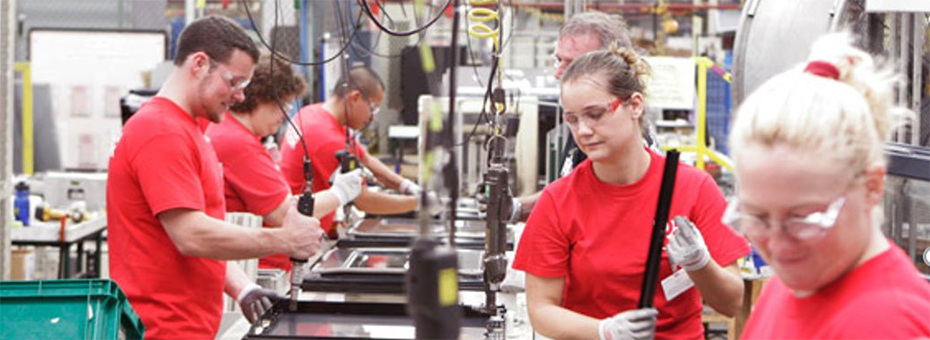GE Appliances (GEA) in Louisville, Kentucky, is cashing in after years of investing in its people. According to CEO Kevin Nolan, business is booming! As with many manufactured goods, customer demand for appliances has been high throughout the pandemic. Yet unlike some of those companies, GEA was ready for it. Its people were ready. Which is to say they were capable problem-solvers.
Kevin’s colleague, Executive Director for Lean Enterprise Marcia Brey, says standardized work is the foundation for their success. It ensures safety, quality, and productivity. (Even when employees with desk jobs step in for frontline workers, which has been necessary due to Covid-related absenteeism). And as importantly, it facilitates one-by-one collaborative problem-solving where it counts – at the gemba. In other words, standardized work enables a Lean WX – a purposefully designed work experience where everybody, every day, is learning and improving through doing value-creating work.
Standardized work enables a Lean WX – a purposefully designed work experience where everybody, every day, is learning and improving through doing value-creating work.
Kevin and Marcia recently participated in LEI’s Virtual Lean Learning Experience, or VLX, where they described the management training program that is creating some of this capability. It’s a one-to-four-week shop floor immersion that’s a requirement for managers, including many who work outside of operations. Participants spend days doing a job on the assembly line, making standardized work for that job, and solving problems with the work.
GEA’s program was inspired by a similar one at Herman Miller, the office furniture manufacturer in Holland, Michigan. Not so long ago, the good and generous folks there allowed me and a colleague to participate in their weeklong Management System Experience (MSE) for managers-in-training. I learned as much in that one week as I have from months, if not years, of other activities. It was awesome!
A management system deeply rooted in the work…
Over the course of five days, MSE had me interacting with all aspects of Herman Miller’s operations management system. On Monday, I shadowed, practiced, and performed the work of conveyance that keeps the assembly line running by moving parts and kanban to and from. In this case, the takt time was 21 seconds, and the route I walked was set to a pitch of 10X takt time (21 seconds X 10 = 210 seconds, or 3 ½ minutes). On Tuesday, I shifted to assembling chairs on the line. After two full days in these cornerstone roles, I stepped into the job of facilitator, i.e., team leader or frontline supervisor. Before the shift ended on Wednesday, I was challenged to eliminate at least one operator’s struggle. On day four, I got promoted to management with responsibility for the entire production line, supporting a handful of facilitators. And finally, on Friday, I walked in the shoes of the plant manager.
Discovering the full system of a purposefully designed work experience was an emotional experience for me.At that point in time, I’d never seen an operations management system at this level of development. (I hadn’t visited Toyota yet.) At Herman Miller, value creators feel the voice of customer, just-in-time, and jidoka through every carefully choreographed motion of their standardized work, and managers enable their success. In particular, jidoka requires managers to respond within cycle time (which is slightly less than takt time) to problems and struggles in a value creator’s work so the line can keep running with perfect quality. It’s incredible.
Intellectually, I had understood how working steadily to takt time weaves a “customer first” orientation throughout an operation by synchronizing the flow of parts, information, and human motions, by setting them in time. And I had a grasp of how the two pillars of TPS – just-in-time and jidoka – enable workers and managers to know if things are (a) ahead/behind and (b) normal/abnormal. I also knew how visualized data about timing and quality from the customer’s perspective can be used to guide efforts to make things better, to solve problems customers actually care about.
But I had never seen it all working together. Nor had I been so fully immersed. I was experiencing it with all my senses, every fiber of my being. At times, and this may sound silly, I was overcome with emotion. It’s true. Never had working affected me in that way. I kept asking myself, “What is it about this work experience that’s so special?”
…enabling a work experience for continuous learning and improvement – Lean WX
For starters, everything, and I mean everything, flowed! Parts were pulled by kanban signals, based on customer demand. When I reached for a part, it was always in stock in exactly the right place. When I needed a particular tool, it was where I wanted it to be. Once I became proficient at the standardized work, which my facilitator assured through use of job instruction, my body moved with the rhythm of a dancer (and I ain’t got much rhythm!). Moreover, this happened for the entire shift. Their use of heijunka – production planning that smoothed out a mixed-model line, leveling its workload – enabled that to happen.
Even when the system exposed and pre-framed a problem, it was perfectly okay.
Every 21 seconds, or every time Herman Miller shipped one chair to a customer, I knew how I was doing, both in terms of timing and quality. We all did. The cumulative effect of receiving steady, instant feedback over time was something I’d never experienced. There I was, shoulder-to-shoulder with my teammates, continually handing off my work to the internal customer standing downstream to my right. And the system kept telling me, over and over again, “You’re doing a good job.”
Even when I wasn’t – when the system exposed and pre-framed a problem – it was perfectly okay! When I, or anyone else, encountered a hiccup, capable support was standing by. This was because problems were expected. I’d simply “pull the Andon,” calling for help, and in a matter of steps and seconds, it would arrive. In fact, because the facilitator was positioned so close to me, constantly looking in my direction, help sometimes arrived before I could send the signal! Never was I made to feel bad, like I’d failed. Quite the opposite – my calls for help were celebrated. Only once did my facilitator express disappointment: when I tried too hard to overcome an obstacle on my own.
In addition to troubleshooting and one-by-one problem-solving, all problems were shown visibly. Physical boards were all around us, displaying easy-to-verify and easier to understand facts about our work. For example, recurring problems were shown on a production analysis board reviewed hourly and daily as part of cadenced huddles. Known tight fits, where cycle time was very close to takt time and operator struggles could be expected, were clearly depicted on yamazumi boards, also known as operator balance charts.
All of it put together encompassed an enabling work experience where I, where everyone, could be successful and keep getting better.
On the day I was a temporary facilitator, I was asked during the morning huddle, “What problem do you think we should address?” I’d never been able to answer that question so easily and so well. “Workstation #9 needs three seconds shaved off its cycle time. Plus, its cycle time fluctuates. Because the unstable cycle is above takt time, the job is hard. It causes injuries and defects.” (In fact, I’d pinched my skin while doing that job the day before.) And just like that, kaizen could begin.
Gemba work at GEA and HM reminded me of the value of creating Lean WXs for all employees and how doing so has enabled them to not only survive, but to thrive.The entire weeklong MSE took place at the gemba – where the value-creating work happens. The only exception was when we stepped away for end-of-day reflections. The effect of this “shop floor focus” on Herman Miller’s management culture was unmistakable. I remember a conversation taking place during a standup meeting toward the end of the week. Several managers were discussing a higher-level business challenge – an unusually large customer order had been received. While figuring out how to handle it, the managers were able to speak in concrete terms and in a detailed way about work element redistribution on the line to permit a reduction in takt time. I was awestruck.
Now’s a good time to build up your immune system
Hearing Kevin and Marcia talk about GEA’s strong business performance during these challenging times was inspirational. They reminded me about the value of creating Lean WXs for all employees and how doing so has enabled them to not only survive, but to thrive. As an organizational leader myself, it’s a challenge I must take on.
Because unfortunately, there are too few Lean WXs out there. Even where they exist, where operating and management systems are well enough developed to sustain them, like at GEA and Herman Miller, immersive learning experiences at the gemba have not been created.
But as someone whose understanding of lean/TPS grew exponentially by going through such an experience – who finally began to “get it in his bones” – I’d encourage every would-be lean enterprise out there, even those who have “only” created a model line, to try this approach to capability development. You won’t regret it when the next challenge, or crisis, comes along. Just ask Kevin and Marcia.
Lean Leadership Learning Tour
Go beyond theory—see lean leadership in action.






